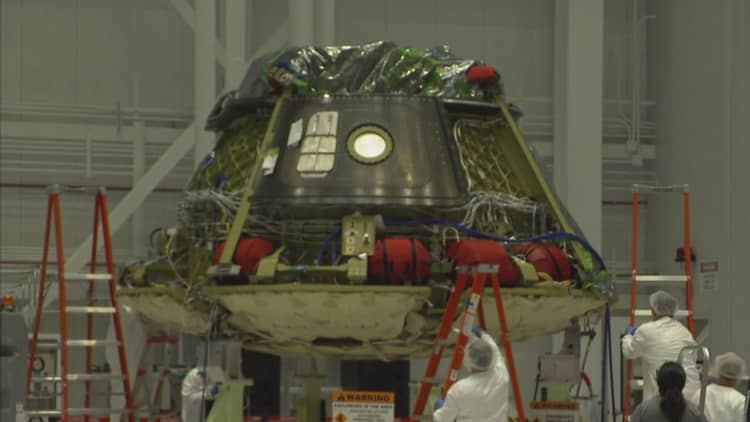
On July 21, 2011, astronaut Chris Ferguson guided the Atlantis back to Earth to conclude the final space shuttle mission. It was the end of an era for launching humans to space from American soil — one he says brought tumbleweeds and empty parking lots to NASA's Kennedy Space Center.
"But then the gates opened in 2014 and tumbleweeds stopped blowing across the road and the cars started showing up in the parking lot," Ferguson, who is now Boeing's director of Starliner crew and mission systems, told CNBC.
Boeing and SpaceX are competing — the former with its Starliner capsules and the latter its Dragon capsules — to fulfill contracts for NASA's Commercial Crew program to ferry astronauts to and from the International Space Station. Both companies are on track to test uncrewed variations in August, according to the most recent NASA announcements, with crewed tests no earlier than November for Boeing and December for SpaceX.
With Starliner nearing its first launch, Boeing took CNBC for a look inside the company's assembly plant at the Kennedy Space Center in Florida.
Three Starliner capsules in progress
Boeing has three spacecraft in progress – Starliners 1, 2 and 3. The first is a launch-abort test module to be used to certify crew escape systems in the event of an emergency. The second is for the crew test and will actually fly after the third, which is being used for the uncrewed test.
"You make sure that you have failure capability that you can degrade gracefully to where you're never in a spot where you can't get the humans home safely," Ferguson said.
That level of safety is not a worry for current U.S. launches of unmanned satellites. But Starliner requires "building a level of redundancy into a vehicle that, no matter how bad of a day, we can always get them home safely," Ferguson said.
Sharing innovations within Boeing
As a company with three multibillion-dollar divisions, Boeing is known for its work as an airplane manufacturer and a defense contractor before its space businesses. But the company says Boeing CEO Dennis Muilenburg is trying to change that with his "One Boeing" initiative, so the company shares resources and talent from within.
One example of Boeing applying Muilenburg's principle is when the company brought in engineers from the commercial airplanes division to teach those in the Starliner program how to use a "shimming tool." In essence, the specialized tool was capable of drilling and installing the black seams (seen below) in a few hours. When done by hand, each seam would have taken about a month to install.
Investments made to refurbish shuttle-era infrastructure
Ferguson says that when Boeing got the Starliner contract in 2014, "the money began to flow and we were able to make this big infrastructure investment to pursue spaceflight."
Starliner's plant was repurposed from the space shuttle days after investment from Space Florida and Boeing. The outline of the shuttle is still visible in the hangar doors, where one can see a cut high in the wall for its tail.
"But as you can see, from that white line on down, this is a new facility. All of the services are new," Ferguson said.
Learning from the space shuttle
Many Starliner employees took part in building and refurbishing shuttles, Ferguson said. While the shuttles were never quite what NASA dreamed they would be, Starliner is built from lessons learned from that program.
The difference is in "how we've exploited the technology we developed for other programs and repurposed it to use here," Ferguson said.
Taking something as simple as a small handle used to break the windows of the shuttle to escape, Ferguson explained that the shuttle had a "nifty handle they made just for that explicit purpose."
"We have our own version of that handle but it's a repurposed F-15 [fighter jet] ordinance selection handle. So we didn't have to make a one-off," Ferguson said. You'd be hard-pressed to find "one-off parts with this vehicle."
"The space shuttle had 1,100 switches, things you could touch. I retired and I still don't think I knew what every switch in that shuttle did," Ferguson said.
Starliner has "on the order of 40," he said, making it a lot more akin to a modern commercial airline cockpit.
The future of commercial space
"The space shuttle, in 2010 dollars, cost between $35 [billion] and $40 billion to develop," Ferguson said.
Beyond the development cost, he noted, it cost $3 billion per year to operate, all for about a half-dozen launches each year.
By comparison, Starliner's contract is worth $4.2 billion for Boeing to build three spacecraft. The company contracted United Launch Alliance to deliver two test flights and six service flights.
Ferguson thinks NASA has "the right approach" to the modern era of the space industry.
"They're underwriting the development of commercial capabilities with the hope that, if they kick-start this, then commercial companies [can] go find other sustaining businesses that can keep them going so that they become entities in and of themselves," Ferguson said.
And from there, "NASA can buy services off of them," Ferguson added, bringing costs for below what has ever been seen before.


